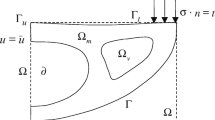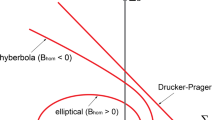Summary
In the most general case, composites composed of two materials, exhibiting a matrix-inclusion morphology, can be described by three phases: the matrix phase, the inclusion phase, and the interface between the inclusion and the matrix. In order to relate effective material properties to the matrix-inclusion behavior and the morphology, i.e., to the arrangement of the inclusions within the matrix phase, analytical and/or numerical schemes may be employed. Regarding effective strength properties, averaging schemes used, e.g., for upscaling elastic and viscoelastic properties are not able to capture the localized mode of material failure and do not provide information about the failure modes within the material. In this paper, the application of limit analysis to two-phase materials subjected to uniaxial/biaxial loading is proposed, giving access to the respective material strength and the corresponding failure modes. Based on a discretized form of limit analysis, different strength properties are assigned to the matrix, the inclusion, and the interface. The solution of the underlying optimization problem arising from the respective upper- and lower-bound formulation is based on second-order-cone-programming (SOCP). The presented upscaling scheme is used to illustrate the finer-scale origin of frequently observed failure and degradation scenaria in matrix-inclusion materials, highlighting the effect of strength properties, morphology, and interface degradation on the effective strength of the composite material.
Similar content being viewed by others
References
Aigner E., Lackner R. and Pichler Ch. (2007). “Bottom–up” multiscale modeling of viscoelastic properties of asphalt. Conf. Proc. Adv. Charact. Pavement Soil Engng. Mater. 1: 123–135
Lackner, R., Mang, H.: Mehrskalenmodelle für die Berechnung von Flächentragwerken [Multiscale models for the analysis of shell structures]. Ernst & Sohn, Betonkalender 2007. In German, Band 2, 19–65
Lemarchand E., Ulm F.J. and Dormieux L. (2002). Effect of inclusions on friction coefficient of highly filled composite materials. J. Engng. Mech. 128(8): 876–884
Barthèlèmy J.F. and Dormieux L. (2004). A micromechanical approach to the strength criterion of Drucker–Prager materials reinforced by rigid inclusions. Int. J. Numer. Anal. Methods Geomech. 28: 565–582
Heukamp F.H., Lemarchand E. and Ulm F.J. (2005). The effect of interfacial properties on the cohesion of highly filled composite materials. Int. J. Solids Struct. 42: 287–305
Zouain N., Herskovits J., Borges L.A. and Feijoo R.A. (1993). An iterative algorithm for limit analysis with non-linear yield functions. Int. J. Solids Struct. 30(10): 1397–1417
Krabbenhoft K., Lyamin A.V., Hjiaj M. and Sloan S.W. (2005). A new discontinuous upper bound limit analysis formulation. Int. J. Numer. Methods Engng. 63(7): 1069–1088
Makrodimopoulos A. and Martin C.M. (2006). Lower bound limit analysis of cohesive-frictional materials using second-order cone programming. Int. J. Numer. Methods Engng. 66(4): 604–634
Lyamin A.V. and Sloan S.W. (2002). Upper bound limit analysis using linear finite elements and nonlinear programming. Int. J. Numer. Anal. Methods Geomech. 26: 181–216
Lyamin A.V. and Sloan S.W. (2002). Lower bound limit analysis using non-linear programming. Int. J. Numer. Methods Engng. 55: 573–611
Krabbenhoft K. and Damkilde L. (2003). A general non-linear optimization algorithm for lower bound limit analysis. Int. J. Numer. Methods Engng. 56: 165–184
Gondzio J. (1995). HOPDM (version 2.12) – a fast LP solver based on a primal-dual interior point method. Eur. J. Oper. Res. 85: 221–225
Abbo A.J. and Sloan S.W. (1995). A smoothed hyperbolic approximation to the Mohr–Coulomb yield criterion. Comput. Struct. 54: 427–441
Makrodimopoulos, A., Bisbos, C.: Shakedown analysis of plane stress problems via SOCP. In: Staat, M., Heitzer, M. (eds.) Numerical Methods for Limit and Shakedown Analysis, pp. 185–216. John von Neumann Institute for Computing (NIC) (2003)
Ciria, H., Peraire, J.: Computation of upper and lower bounds in limit analysis using second-order cone programming and mesh adaptivity. In: 9th ASCE Specialty Conference on Probabilistic Mechanics and Structural Reliability (2004)
Makrodimopoulos A. (2006). Computational formulation of shakedown analysis as a conic quadratic optimization problem. Mech. Res. Commun. 33: 72–83
Andersen E.D., Roos C. and Terlaky T. (2003). On implementing a primal-dual interior-point method for conic quadratic optimization. Math. Program. Ser. B 95: 249–277
MOSEK ApS (2006) The MOSEK optimization tools version 4.0 (revision 35). In: User’s manual and reference. http://www.mosek.co. Cited 2006
Makrodimopoulos, A., Martin, C.M.: Upper bound limit analysis using discontinuous quadratic displacement fields. Commun. Numer. Methods Engng. (2007) (in print)
Author information
Authors and Affiliations
Corresponding author
Additional information
Dedicated to Professor Franz Ziegler on the occasion of his 70th birthday
Rights and permissions
About this article
Cite this article
Füssl, J., Lackner, R., Eberhardsteiner, J. et al. Failure modes and effective strength of two-phase materials determined by means of numerical limit analysis. Acta Mech 195, 185–202 (2008). https://doi.org/10.1007/s00707-007-0550-9
Received:
Accepted:
Published:
Issue Date:
DOI: https://doi.org/10.1007/s00707-007-0550-9




